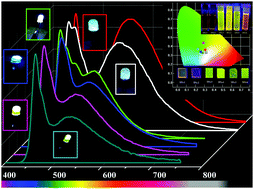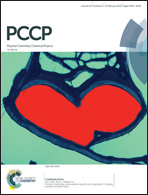Triphenylamine based yellowish-orange light emitting organic dyes (donor–π–acceptor) for hybrid WLEDs and OLEDs: synthesis, characterization and theoretical study†
Abstract
Six novel yellowish-orange light emitting dye molecules consisting of an electron deficient phenone (acceptor) linked to triphenylamine (donor), were designed and synthesized. The photophysical and electrochemical properties of the dyes were systematically investigated and examined using DFT calculations. All the synthesized dye materials have shown high quantum yields (ranging from 0.35to0.74%). The dyes emitted intense yellowish-orange (x = 0.427, y = 0.481) to orange color (x = 0.511, y = 0.484) with appropriate CIE color coordinates. The synthesised dyes were used for generating white light by fabricating white LEDs. Among all hybrid white LED devices TPA-2 has shown bright white emission with CIE color coordinates x = 0.32, y = 0.33. Theoretical calculations have been performed to explore the optical, electronic, charge transport, and stability properties of the TPA derivatives as charge transport and emissive materials for organic light emitting devices (OLEDs). The results show that, all the derivatives are highly luminescent and their hole transport performances are more favourable than their electron transport performances. So these materials can be used as hole transport materials for OLEDs.



 Please wait while we load your content...
Please wait while we load your content...